Charity
Parastoo Anoushahpour, Faraz Anoushahpour, Ryan Ferko
2021
| 36 min
Interactive Documentary
English with French Subtitles
Awards and Festivals
nfb.ca/charity
In July 2017, residents of Cathedraltown, a suburban development in Markham, Ontario, awoke to find Charity, a giant chrome replica of a cow, facing their homes. The residents, however, had never been consulted about the installation of their new eight-metre high bovine neighbour, and quickly rose in opposition to the sculpture. After a barrage of complaints and numerous municipal-level discussions, the city council agreed to remove the controversial cow.
Charity looks at the unlikely controversy surrounding suburban public art, focusing on the bureaucratic processes that unfolded over several years in the Markham City Council as a way to consider the broader forces at play in our municipal democracies. Presented as a public digital artwork produced by the National Film Board of Canada in partnership with MOCA Toronto, this interactive documentary raises questions about the identity of a place, who determines it and the challenges of representing multiple subjective experiences and histories simultaneously.
Trailer
Long Synopsis
In July 2017, residents of Cathedraltown, a suburban development in Markham, Ontario, awoke to find Charity, a chrome replica of a prize-winning Holstein cow—double her actual life size and standing on eight-metre-tall stilts—facing their homes. The public art piece, honouring the so-called “greatest cow of all time,” was commissioned by Cathedraltown’s developer and donated to the City of Markham. The sculpture was meant to pay tribute to the history of the site, which was supposedly home to Canada’s leading breeder and exhibitor of Holstein cows. It would later become clear that Charity never actually lived there herself.
The residents, however, had never been consulted about the installation of their new bovine neighbour. They quickly rose in opposition to the sculpture, which they felt did not represent their culturally shifting community. After mockery in the media, a barrage of complaints and numerous municipal-level discussions, the city council agreed to remove the controversial cow.
From the same council chamber where land is subdivided, rezoned and repurposed, decisions are also made about how public art should contextualize places. Charity looks at the unlikely controversy surrounding suburban public art, focusing on the bureaucratic processes that unfolded over several years in the Markham City Council as a way to consider the broader forces at play in our municipal democracies.
The artwork raises questions about the identity of a place, who determines it and the challenges of representing multiple subjective experiences and histories simultaneously. It is a case study in what can happen when a cultural symbol is set against an ever-changing cultural climate.
Presented as a public digital artwork produced by the National Film Board of Canada in partnership with MOCA Toronto, this interactive documentary employs 360° video and photogrammetry to present a variation on the familiar interactive real-estate tour––where a house in Cathedraltown becomes a site to collect and re-narrate a community’s confrontation with a piece of public art, in turn offering a portrait of private property.
One and Two-Liner
ONE-LINER
Charity is an interactive documentary that explores the controversy and bureaucracy around an oversized chrome cow placed in a suburban neighbourhood as public art.
TWO-LINER
Charity is an interactive documentary by the artist collective of Parastoo Anoushahpour, Faraz Anoushahpour and Ryan Ferko. It explores the controversy and bureaucracy around an oversized chrome cow placed in a suburban neighbourhood as public art, raising questions about the identity of a place and who determines it.
About the User Experience
Charity is a public digital artwork that explores the unlikely controversy caused by an oversized chrome cow being placed in a suburban neighbourhood as public art. The experience opens with Charity, the eight-metre-tall cow sculpture in question, being modelled in 3D on a computer monitor, while an audio recording (along with a transcript) from the Markham City Council establishes the bureaucratic tone. A montage further introduces the prize-winning Holstein cow replica and gives the viewer a glimpse of Markham during its development, long before the arrival of the bovine champ. With the scene set for a Kafkaesque romp, the film turns interactive by employing 360° video and photogrammetry to present a variation on the familiar interactive real-estate tour. As we navigate a house in Cathedraltown, it becomes a site to reconsider a community’s confrontation with a piece of public art, in turn offering a portrait of private property. The audio draws us further into the quasi-absurdist hole that is the council meetings in which the merits of the sculpture, and its ultimate removal, are discussed. The municipal-level bickering makes us consider the broader forces at play in our democracies and what can happen when a cultural symbol is set against an ever-changing cultural climate. With a running time of approximately 36 minutes, this interactive documentary is an immersive and innovative case study in the challenges of representing multiple subjective experiences and histories simultaneously.
About the MOCA–NFB Partnership
The MOCA and NFB partnership was created with a view stemming from a common desire to work with artists from outside the NFB’s normal sphere of influence, and to attract new audiences from adjacent fields. Working in unison, the two organizations have engaged the artist collective of Parastoo Anoushahpour, Faraz Anoushahpour and Ryan Ferko to create a responsive digital-media artwork that will be shown to the public during the Greater Toronto Art 2021 triennial.
Charity runs parallel to a new film called Surface Rites, also presented as part of the Greater Toronto Art 2021 (GTA21) exhibition at Museum of Contemporary Art, Toronto from September 29, 2021 – January 9, 2022. Peering beyond the suburban landscape of Cathedraltown, Surface Rites looks at the land itself and the processes of mining and prospecting so intertwined with settler colonialism and the creation of North American suburbs.
Q&A with the Artists
Why is this story relevant now?
The story considers the broader forces at play in our municipal democracies and raises questions about the identity of a place, who determines it and the challenges of representing multiple subjective experiences and histories simultaneously. This is set against the backdrop of an ongoing conversation about the role of public art and the ways that it overlaps with development and private property, as well as the narration of land and histories.
Do you have a personal relationship to the site, or what attracted you to the story?
What initially attracted us to this location was the cathedral itself. Back in 2013, we encountered this uncanny object off the side of Highway 404. Our initial visit to the site resulted in a few rolls of black-and-white film. This marked the beginning of our interest in the place broadly, at a moment when the surrounding suburb of Cathedraltown was still very much under construction. As with most of our projects, this relationship developed slowly over time and took on many directions. As we were asking questions about what it meant for a replica of a Slovak church to become the symbolic centre of a suburban development north of Toronto, the controversy surrounding Charity the cow began to unfold. In an unexpected way, the story of Charity came to mirror the story of the Cathedral, both as objects meant to bring a certain identity to a new suburban development. The thing that then attracted us to Charity as a story to focus on in and of itself was the way the community asserted themselves by appealing to the municipal government and, in the process, provided a portrait of the community.
How is working as a collective different from working alone?
We have been working as a collective since 2013. We bring our backgrounds in architecture, theatre design and history to the projects that we work on, as well as our different ways of seeing and being in the world. Mostly creating work about places, our three different experiences and perspectives allow us to make projects that we hope are both coherent and singular in form, while also offering new and complex ways of thinking about place.
Do you think the story is a particularly Canadian one?
On the surface this story is very localized to a specific suburban development in Markham. Our interest in this story, however, lies in the belief that it offers a much wider resonance in thinking about questions of identity, belonging and self-representation in relation to suburban environments throughout Canada, and North America in general. As cities like Toronto continue to become prohibitively expensive to live in, we have seen the suburbs continue to proliferate and expand. It remains very expensive to buy a house in the suburbs as well, and within these large homes are often multiple generations of families. On land that was entirely owned by one man who immigrated from Slovakia in the 1950s, now live hundreds of families, many of whom are themselves first- or second-generation Canadians. How Indigenous land came to be owned in the first place, and then later redeveloped as a suburb, is a wider question for all Canadians.
Why an interactive documentary as opposed to a documentary?
This project began as a film, slowly unfolding over many years since our first visit in 2013. In 2020, we were asked by the Museum of Contemporary Art Toronto to show some of this work for the first time, and also if we would be interested in potentially working with the NFB Digital Studio in Vancouver to expand some new elements of the project. From there we found ourselves working within the context of pandemic lockdowns and the Studio’s mandate to work with interactive technology in order to bring different types of projects to audiences. Normally showing our work in cinemas or galleries, we were provided an opportunity to shift our way of working, while also being careful to ask what elements needed to be in the audience’s control, and what needed to be shaped and formed by an intentional narrative. The interactive elements, we hope, add an expanded layer to this narrative form, without distracting or digressing too far from the story at hand. We were also interested in making an accessible work that could be listened to, watched or read, and ensuing that any of those experiences would be equal in form and content.
What are the conversations you want to provoke?
Beyond conversations about the unusual story of Charity the cow and the drawn-out bureaucratic process that unfolded in Markham’s Town Hall in 2017 and 2018, we hope that the work raises broader questions around municipal democracies and private property. How is space represented and how are narratives and histories constructed and controlled? Who gets to dictate those narratives? One of the main issues that residents began to raise when opposing the Charity the cow sculpture is that the cow never actually lived in Markham, despite the donor’s intention to use Charity as a symbol to represent the agricultural history of the area before it became a suburban development. Beyond this, the idea of an agricultural history as a point of origin for this land continues to erase Indigenous histories and sovereignty, perpetuating a settler-colonial control of land and its narration.
What’s the relationship, if any, between this work and the removal of problematic statues for political reasons? Are you interested in that debate?
This work is related, though maybe in a less obvious way than in the case of a statue of an individual. If you peel back the layers of how the cow statue came to be installed in that location, what it was meant to represent and what it was meant to conceal, you will see the through line of wealth, resource extraction, settler-colonialism, patriarchy and white supremacy that’s at the heart of the conversations around sculptures that more directly represent and glorify key figures within that history, and are so crucial in a certain narration of place.
Why did you decide on the 360 video and photogrammetry for this particular piece?
The decision to work with 360 video and photogrammetry came from real estate, after we spent a lot of time going to open houses and looking at real estate listings in the Markham area as part of our research. We are often drawn to the kinds of images that are produced in a sort of utilitarian and functional way from within the places that we work with. We found that these two modes of image making were already embedded and used within the visual language of real estate and the context of the project. So, working within that gave us an angle to think through some of the formal and aesthetic themes and concerns of the project to re-narrate the bureaucratic narrative of Charity the cow.
Additional Reading
Excerpt #1
Excerpt #2
Excerpt #3
Images
Loading...
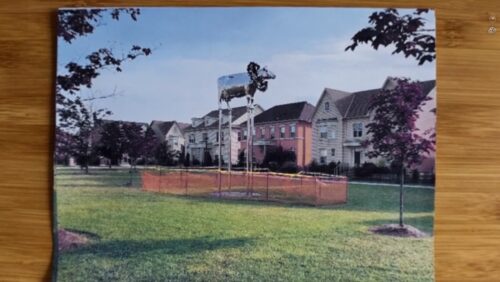
Download
Loading...
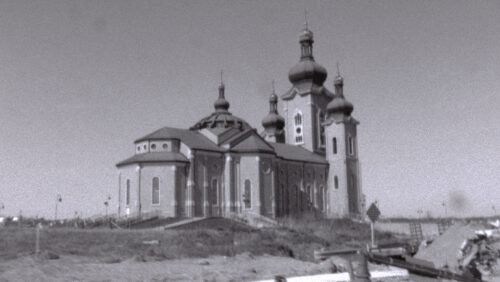
Download
Loading...
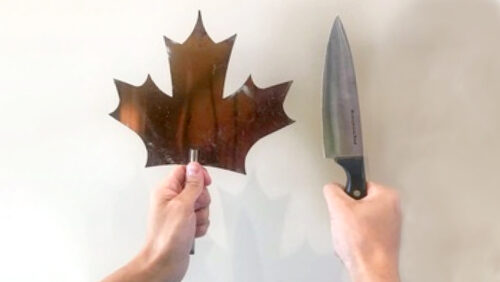
Download
Loading...
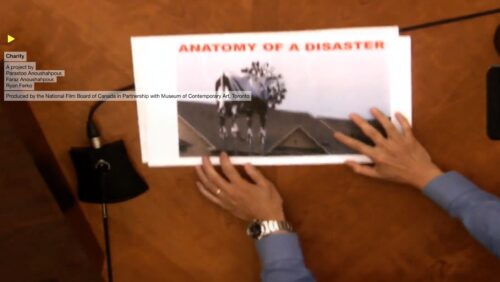
Download
Loading...
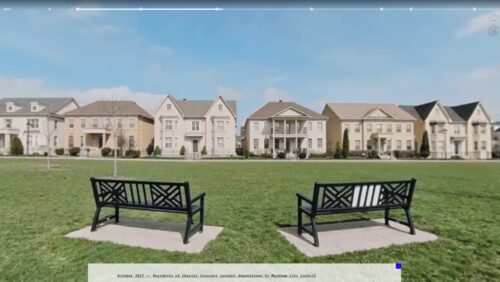
Download
Loading...
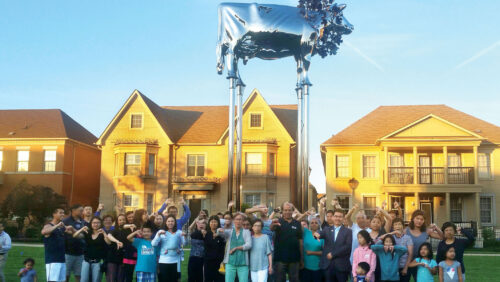
Download
Broadsheet
Loading...
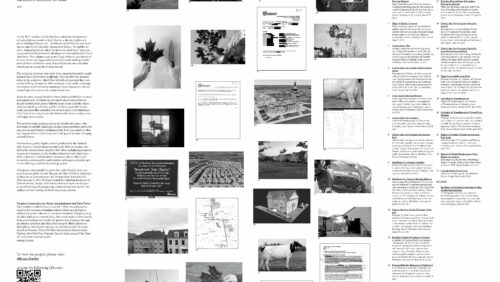
Download
Team
Parastoo Anoushahpour, Faraz Anoushahpour & Ryan Ferko
Creators
Photo
Jeremy Mendes
Producer
Photo
Photo : Adam Gilmer
Rob McLaughlin
Executive Producer
Photo
Photo : Emily Cooper
Credits
A project by
Parastoo Anoushahpour
Faraz Anoushahpour
Ryan Ferko
Written by
Parastoo Anoushahpour
Faraz Anoushahpour
Ryan Ferko
Produced by the National Film Board of Canada in Partnership with Museum of Contemporary Art, Toronto
Camera, editing and sound design
Parastoo Anoushahpour
Faraz Anoushahpour
Ryan Ferko
UI Design and Development
Thinkingbox
Performer
Chantria Tam
3D Modeller
Vincent McCurley
Sound Recording
Benjamin Barton
Production Manager
Amy Gotting
Colour Correction
Dave Roman
Sound Mastering
Joshua Stevenson
French Translation
Marie-Eve Fortin
Museum of Contemporary Art, Toronto
Adjunct Curator
Rui Mateus Amaral
Artistic Director
November Paynter
National Film Board of Canada
Producer
Jeremy Mendes
Executive Producer
Rob McLaughlin
Project Manager
Camille Fillion
Senior Production Coordinator
Jasmine Pullukatt
Operations Managers
Camille Fillion
Janine Steele
Studio Administrator
Victoria Angell
Marketing Manager
Laurianne Desormiers
Publicist
Jennifer Mair
Marketing Coordinator
Éric Bondo
Information Technology
Sergiu Raul Suciu
Digital Platforms
Catherine Perreault
Legal Services
Peter Kallianotis
Social Media
Hannah Martin
Licensed Photos from
Metroland York Region / Susie Kockerscheidt
Metroland York Region / Tim Kelly
News footage courtesy of
Rogers Media Inc.
Bell Media Inc
Media Relations
-
About the NFB
The National Film Board of Canada (NFB) is one of the world’s leading digital content hubs, creating groundbreaking interactive documentaries and animation, mobile content, installations and participatory experiences. NFB interactive productions and digital platforms have won over 100 awards, including 21 Webbys. To access this unique content, visit NFB.ca.
-
About MOCA
MOCA (formerly known as the Museum of Contemporary Canadian Art – MOCCA) has been celebrated for its incisive, artist-centric approach to programming, and hospitable visitor experience.
MOCA is motivated by our belief that museums can be culturally and socially useful. We promote exceptional artistic thinking and provide a community space for discourse and creativity.
Working across all contemporary art forms, we empower the local Toronto art scene, while informing the international. MOCA is an accessible, welcoming hub rooted and engaged in a culturally rich neighbourhood; it is here, through art, that you can feel the specialness of this invigorating and hyper-diverse city.